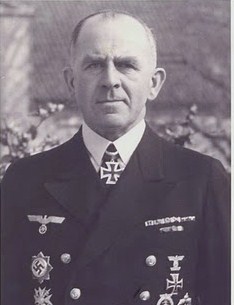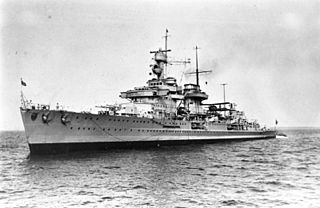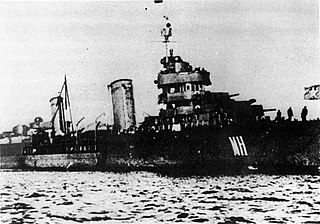Related Research Articles

Deutschland was the lead ship of her class of heavy cruisers which served with the Kriegsmarine of Nazi Germany during World War II. Ordered by the Weimar government for the Reichsmarine, she was laid down at the Deutsche Werke shipyard in Kiel in February 1929 and completed by April 1933. Originally classified as an armored ship by the Reichsmarine, in February 1940 the Germans reclassified the remaining two ships of this class as heavy cruisers. In 1940, she was renamed Lützow, after the unfinished Admiral Hipper-class heavy cruiser Lützow was sold to the Soviet Union the previous year.

The Soviet Navy was the naval warfare uniform service branch of the Soviet Armed Forces. Often referred to as the Red Fleet, the Soviet Navy made up a large part of the Soviet Union's strategic planning in the event of a conflict with the opposing superpower, the United States, during the Cold War (1945–1991). The Soviet Navy played a large role during the Cold War, either confronting the North Atlantic Treaty Organization in western Europe or power projection to maintain its sphere of influence in eastern Europe.

Admiral Hipper was the lead ship of the Admiral Hipper class of heavy cruisers which served with Nazi Germany's Kriegsmarine during World War II. The ship was laid down at the Blohm & Voss shipyard in Hamburg in July 1935 and launched February 1937; Admiral Hipper entered service shortly before the outbreak of war, in April 1939. The ship was named after Admiral Franz von Hipper, commander of the German battlecruiser squadron during the Battle of Jutland in 1916 and later commander-in-chief of the German High Seas Fleet. She was armed with a main battery of eight 20.3 cm (8 in) guns and, although nominally under the 10,000-long-ton (10,160 t) limit set by the Anglo-German Naval Agreement, actually displaced over 16,000 long tons (16,260 t).

Otto Ciliax was a German naval officer who served in the navies of the German Empire, the Weimar Republic and Nazi Germany. As an admiral during World War II, he commanded the German battleships. He was a recipient of the Knight's Cross of the Iron Cross.

Nürnberg was a German light cruiser of the Leipzig class built for the Kriegsmarine. She was named after the city of Nuremberg and had one sister ship, Leipzig. Nürnberg was laid down in 1934, launched in December of that year, and completed in November 1935. She was armed with a main battery of nine 15 cm (5.9 in) guns in three triple turrets and could steam at a speed of 32 knots. Nürnberg was the longest-serving major warship of the Kriegsmarine, and the only one to see active service after the end of World War II, though not in a German navy.

The Admiral Hipper class was a group of five heavy cruisers built by Nazi Germany's Kriegsmarine beginning in the mid-1930s. The class comprised Admiral Hipper, the lead ship, Blücher, Prinz Eugen, Seydlitz, and Lützow. Only the first three ships of the class saw action with the German Navy during World War II. Work on Seydlitz stopped when she was approximately 95 percent complete; it was decided to convert her into an aircraft carrier, but this was not completed either. Lützow was sold incomplete to the Soviet Union in 1940.

Köln was a light cruiser, the third member of the Königsberg class that was operated between 1929 and March 1945, including service in World War II. She was operated by two German navies, the Reichsmarine and the Kriegsmarine. She had two sister ships, Königsberg and Karlsruhe. Köln was built by the Reichsmarinewerft in Wilhelmshaven; she was laid down in August 1926, launched in May 1928, and commissioned into the Reichsmarine on 15 January 1930. She was armed with a main battery of nine 15 cm SK C/25 (5.9-inch) guns in three triple turrets and had a top speed of 32 knots.

The Regele Ferdinand class was a pair of destroyers built in Italy for the Romanian Navy during the late 1920s. The sister ships were the most modern and powerful warships of the Axis powers in the Black Sea during World War II. During the war they participated in the 1941 Raid on Constanța and the 1944 evacuation of the Crimea, although they spent the vast majority of the war escorting convoys in the Black Sea. The Romanians claimed that they sank two submarines during the war, but Soviet records do not confirm their claims. Following King Michael's Coup, where Romania switched sides and joined the Allies in late 1944, the two ships were seized and incorporated into the Soviet Black Sea Fleet. They were returned to Romania in 1951 and served until 1961 when they were scrapped.

SMS Niobe was the second member of the ten-ship Gazelle class of light cruisers that were built for the German Kaiserliche Marine in the late 1890s and early 1900s. The Gazelle class was the culmination of earlier unprotected cruiser and aviso designs, combining the best aspects of both types in what became the progenitor of all future light cruisers of the Imperial fleet. Built to be able to serve with the main German fleet and as a colonial cruiser, she was armed with a battery of ten 10.5 cm (4.1 in) guns and a top speed of 21.5 knots. The ship had a long career, serving in all three German navies, along with the Yugoslav and Italian fleets over the span of more than forty years.

The German destroyer Z4 Richard Beitzen was one of four Type 1934 destroyers built for the German Navy (Kriegsmarine) during the mid-1930s. Completed in 1937, the ship spent most of her time training although she did participate in the occupation of Memel in early 1939. At the beginning of World War II in September 1939, the ship was initially deployed to blockade the Polish coast, but was soon transferred to the Kattegat where she inspected neutral shipping for contraband goods. In late 1939 and early 1940, the ship laid two offensive minefields off the English coast that claimed 17 merchant ships. Z4 Richard Beitzen was in reserve during the Norwegian Campaign of early 1940 and was transferred to France later that year, where she made several attacks on British shipping.

Tirpitz was the second of two Bismarck-class battleships built for Nazi Germany's Kriegsmarine (navy) prior to and during the Second World War. Named after Grand Admiral Alfred von Tirpitz, the architect of the Kaiserliche Marine, the ship was laid down at the Kriegsmarinewerft in Wilhelmshaven in November 1936 and her hull was launched two and a half years later. Work was completed in February 1941, when she was commissioned into the German fleet. Like her sister ship, Bismarck, Tirpitz was armed with a main battery of eight 38-centimetre (15 in) guns in four twin turrets. After a series of wartime modifications she was 2000 tonnes heavier than Bismarck, making her the heaviest battleship ever built by a European navy.

Z16 Friedrich Eckoldt was a Type 1934A-class destroyer built for Nazi Germany's Kriegsmarine in the late 1930s. It was named after Kapitänleutnant Friedrich Eckoldt (1887–1916), the commander of torpedo boat V 48, who was killed when his boat was sunk during the Battle of Jutland on 31 May 1916.

Lützow was a heavy cruiser of Nazi Germany's Kriegsmarine, the fifth and final member of the Admiral Hipper class, but was never completed. The ship was laid down in August 1937 and launched in July 1939, after which the Soviet Union requested to purchase the ship. The Kriegsmarine agreed to the sale in February 1940, and the transfer was completed on 15 April. The vessel was still incomplete when sold to the Soviet Union, with only half of her main battery of eight 20.3 cm (8 in) guns installed and much of the superstructure missing.

NMS Mărăști was one of four Vifor-class destroyers ordered by Romania shortly before the beginning of the First World War from Italy. All four sister ships were requisitioned when Italy joined the war in 1915. Originally named Vijelie by the Romanians, she was renamed Sparviero in Italian service. Not completed until mid-1917, the ship engaged Austro-Hungarian ships in the Adriatic Sea only twice before the war ended in November 1918. She was given a new name as Mărăști when she was re-purchased by the Romanians in 1920.

NMS Mărășești was one of four Vifor-class destroyers ordered by Romania shortly before the beginning of the First World War from Italy. All four sister ships were requisitioned when Italy joined the war in 1915. Originally named Vârtej by the Romanians, she was renamed Nibbio in Italian service. Not completed until mid-1918, the ship engaged Austro-Hungarian ships in the Adriatic Sea only once before the war ended in November. She was renamed Mărășești when she was re-purchased by the Romanians in 1920.

Minsk was one of six Leningrad-class destroyer leaders built for the Soviet Navy during the 1930s, one of the three Project 38 variants. Completed in 1939, the ship was assigned to the Baltic Fleet and played a minor role in the Winter War against Finland in 1939–1940. After the start of Operation Barbarossa, the German invasion of the Soviet Union in June 1941, Minsk covered minelaying operations and provided naval gunfire support to Soviet units. She escorted ships during the Soviet evacuation of Tallinn, Estonia, in late August. The ship was sunk by German dive bombers on 23 September, although her wreck was salvaged in 1942 and repaired. Minsk was recommissioned in 1943 but the repairs were not completed until the following year. The ship was reclassified as a training ship in 1951, then became a target ship in 1958 and was sunk that year.

Steregushchy was one of 29 Gnevny-class destroyers built for the Soviet Navy during the late 1930s. Completed in 1939, she was assigned to the Baltic Fleet. The ship played a minor role in the Winter War of 1939–1940 against the Finns. After the start of the German invasion of the Soviet Union in June 1941, Steregushchy participated in the Gulf of Riga Campaign. The ship briefly provided naval gunfire support during the Siege of Leningrad before she was sunk by German dive bombers on 21 September. Her wreck was refloated in 1944, although the repairs were not completed until 1948. Steregushchy was broken up for scrap in 1959.

Stremitelny was one of 29 Gnevny-class destroyer built for the Soviet Navy during the late 1930s. Completed in 1938, the ship was assigned to the Baltic Fleet and played a minor role in the 1939–1940 Winter War against Finland. Stremitelny was transferred to the Northern Fleet in mid-1940. After the start of the German invasion of the Soviet Union in June 1941, she covered an amphibious landing along the Arctic coast. The ship was attacked and sunk by German dive bombers the following month in Polyarny with the loss of 111 crew and passengers. Her wreck was partially salvaged the following year.
Serdity was one of 18 Storozhevoy-class destroyers built for the Soviet Navy during the late 1930s. Although she began construction as a Project 7 Gnevny-class destroyer, Serdity was completed in 1940 to the modified Project 7U design.
Stroyny was one of 18 Storozhevoy-class destroyers built for the Soviet Navy during the late 1930s. Although she began construction as a Project 7 Gnevny-class destroyer, Stroyny was completed in 1942 to the modified Project 7U design.
References
- Philbin, Tobias R. (1994). The Lure of Neptune: German-Soviet Naval Collaboration and Ambitions, 1919–1941. Columbia, SC: University of South Carolina Press. ISBN 978-0-87249-992-8.
- Hildebrand, Hans H.; Henriot, Ernest (1988). Deutschlands Admirale, 1849-1945: Die Militärischen Werdegänge der See-, Ingenieur-, Sanitäts-, Waffen- und Verwaltungsoffiziere im Admiralsrang. Vol. I. Osnabrück: Biblio. ISBN 3764814993.
- Rohwer, Jürgen; Monakov, Mikhail S. (2001). Stalin's Ocean-Going Fleet: Soviet Naval Strategy and Shipbuilding Programmes, 1935–1953. London: Frank Cass. ISBN 978-0-7146-4895-8.